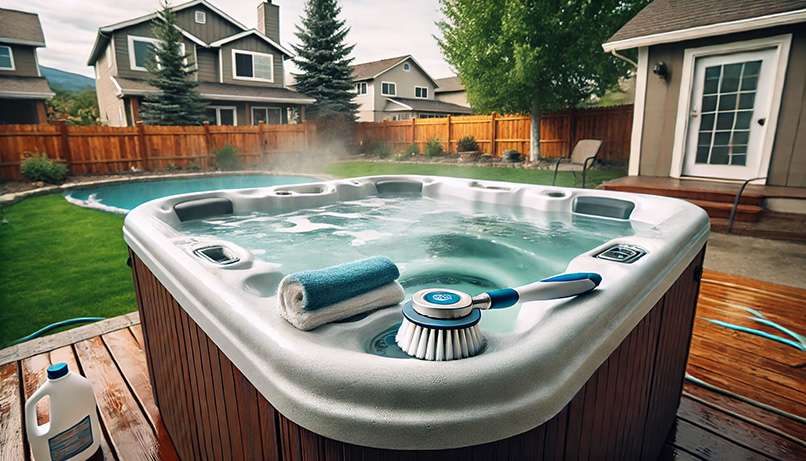Owning a hot tub is a fantastic way to unwind, ease muscle tension, and enjoy daily relaxation right in your backyard. But if you’re using your hot tub frequently, you might wonder: “Is it OK to use the hot tub every day?” The short answer is yes—with the right precautions and proper maintenance. In this post, we’ll explore the benefits, risks, and why routine upkeep is essential for those who love to soak daily.
Benefits of Daily Hot Tub Use
Soaking in a hot tub daily can provide mental and physical health benefits. Here’s why it can become a great addition to your wellness routine:
1. Boosted Immune System
Using your hot tub daily may also support your immune system. Warm water helps flush toxins from your body by increasing circulation and opening your pores. By reducing stress, hot tub use also helps lower the risk of stress-related illnesses, which can impact immune health.
2. Improved Blood Circulation
Daily hot tub use can enhance blood flow by dilating your blood vessels, which allows more oxygen and nutrients to reach your muscles and tissues. This improves muscle recovery and reduces soreness, especially after physical activity. It's particularly beneficial for those with poor circulation or who suffer from muscle stiffness.
3. Stress Relief
Hot tubs help you relax by reducing cortisol levels, the stress hormone, and promoting feelings of calmness. Regular hot tub use has been shown to reduce anxiety and improve sleep quality by calming your nervous system and helping you unwind. Incorporating a hot tub soak into your daily routine can lower stress levels and support your mental health.
4. Improved Sleep
If you have trouble falling or staying asleep, a hot tub soak before bed could help. Warm water raises your body temperature, and as your body cools down afterward, it signals your brain that it's time to sleep. Studies show that hot water immersion before bed can promote deeper, more restful sleep.
5. Enhanced Flexibility and Range of Motion
Regular hot tub use can improve your flexibility and range of motion. The warm water helps loosen tight muscles and relax tendons, making stretching easier and more effective. This can be particularly beneficial for athletes or those recovering from injuries, as daily soaking in a hot tub can make it easier to maintain mobility and prevent stiffness.
6. Joint and Muscle Pain Relief
Hot tubs are a natural form of hydrotherapy for those with arthritis, joint pain, or muscle stiffness. The warm water relieves inflammation, reduces pain, and improves mobility. The buoyancy of the water takes the pressure off your joints, making it easier to move without discomfort, while the heat helps muscles relax.
For more information on the benefits of daily hot tub use, see our articles:
“5 Ways Hot Tubs Can Help Improve Your Health,”
“3 Surprising Health Benefits of Hot Tubs You Can’t Afford to Miss.”
Precautions for Daily Hot Tub Use
While daily hot tub use offers many benefits, it’s essential to follow these precautions to stay safe:
1. Limit Soaking Time
It's recommended to soak for 15-30 minutes at a time. Extended time in hot water can lead to dehydration or overheating. If you plan a longer soak, take short breaks to cool down. If you're new to hot tub use, start with shorter sessions and gradually increase your time.
2. Stay Hydrated
Soaking in a hot tub makes you sweat, even though it might not be as obvious as exercising. This can lead to dehydration if you're not drinking enough water. Always have a bottle of water nearby, and make sure to hydrate before, during, and after your soak. Avoid alcohol while hot tubbing, as it can increase the risk of dehydration and dizziness.
3. Keep the Water Temperature Safe
The ideal water temperature for hot tubs is between 100°F and 104°F (37°C-40°C). Higher temperatures can cause overheating, especially for people with heart conditions. If you use the hot tub daily, keep the temperature on the lower end (around 100°F) to ensure a safe and comfortable experience
4. Consult Your Doctor if Needed
If you have underlying health conditions, such as heart disease or high blood pressure, or if you're pregnant, consult your doctor before committing to daily hot tub use. Heat exposure might not be advisable for everyone, and it's best to get personalized advice based on your health.
For more information on pregnancy and hot tub use, see our article:
Why Regular Maintenance is Essential for Daily Hot Tub Use
Frequent hot tub use requires regular maintenance to keep the water clean and safe. Without proper upkeep, your hot tub could harbor harmful bacteria, leading to health risks. Here’s why routine maintenance is critical:
1. Preventing Bacteria and Algae Growth
Bacteria and Infections in Hot Tubs
Hot tubs can become breeding grounds for harmful bacteria and algae if not properly sanitized. One common bacterium, Pseudomonas aeruginosa, is responsible for causing “hot tub rash” (Pseudomonas folliculitis). This infection leads to itchy, red bumps or blisters on the skin and typically appears a few days after exposure to contaminated water. In rare cases, Pseudomonas can also lead to urinary tract infections (UTIs).
Legionella and Serious Health Risks
Another potential risk in poorly maintained hot tubs is Legionella, the bacterium that causes Legionnaires’ disease. This serious lung infection is usually contracted by inhaling small water droplets containing the bacteria. Hot tubs that aren’t properly cleaned and maintained can harbor Legionella, putting users at risk for this severe form of pneumonia.
To prevent these health risks, it’s essential to regularly clean your hot tub, use proper water filtration, and maintain the correct chemical balance. Proper maintenance helps ensure harmful bacteria like Pseudomonas and Legionella do not thrive in your hot tub environment.

2. UTIs and Hot Tub Use
While hot tubs don’t directly cause UTIs, sitting in unsanitary water increases the likelihood of bacterial contamination. Bacteria, such as Escherichia coli (E. coli), can enter the urinary tract, especially in women, due to their shorter urethras. To minimize this risk:
- Keep Chemical Levels Balanced: Regularly test the water to ensure proper chlorine or bromine levels.
- Shower Before and After: Rinse off before entering the hot tub and after your soak to reduce the risk of bacteria transferring to your body.
- Stay Hydrated: Drinking water can help flush bacteria from your system, reducing the risk of infection.
3. Cleaning the Filter
Your hot tub’s filter traps dirt, oils, and other debris. The filter will clog more quickly with daily use, reducing its effectiveness. A dirty filter can also strain the pump and heater, leading to costly repairs. Clean your filter every 1-2 weeks and replace it as needed to ensure smooth operation.
4. Maintaining Proper Chemical Balance
Even with the proper chemical balance, water needs to be changed every few months, especially for frequent users. Over time, contaminants like body oils, lotions, and other particles can build up, reducing the effectiveness of the chemicals and affecting water clarity. For those using the hot tub daily, it’s recommended to drain and refill the water every 2-3 months.
5. Draining and Refilling the Water
Daily hot tub use means frequent exposure to chemicals like chlorine or bromine, which are necessary to keep the water free of harmful contaminants. Imbalanced water can lead to skin irritation, eye redness, or respiratory problems. It’s recommended that the water’s chemical levels be tested at least twice a week and adjusted as needed.
6. Protecting Your Investment
Regular maintenance keeps your hot tub clean and extends its lifespan. Neglecting basic upkeep can lead to expensive repairs and a shorter lifespan. Maintaining proper chemical levels, cleaning the filter, and changing the water regularly ensures your hot tub remains a safe and enjoyable place to relax.
Conclusion: Is It OK to Hot Tub Every Day?
Yes, using a hot tub daily is safe if you follow basic safety guidelines and perform regular maintenance. The benefits—ranging from improved circulation and stress relief to better sleep and joint pain relief—make daily hot tub use a fantastic addition to your wellness routine. Remember to keep the water clean, limit your soak time, and stay hydrated.
At Love’s Hot Tubs, we offer a range of high-quality hot tubs designed for daily use. Whether you’re looking for a luxurious model or a budget-friendly option, we have the perfect hot tub to suit your needs. Visit us today to explore our selection and make relaxation a daily habit!

References:
- “Preventing Hot Tub Rash,” Centers for Disease Control and Prevention (CDC).
- “Controlling Legionella in Hot tubs,” Centers for Disease Control and Prevention (CDC).
- “Vacation Rental Owners and Managers,” Centers for Disease Control and Prevention (CDC).
- “Hydrotherapy for RA: Does It Work?,” Healthline.
- “Does Hydrotherapy Impact Behaviours Related to Mental Health and Well-Being for Children with Autism Spectrum Disorder? A Randomised Crossover-Controlled Pilot Trial,” PubMed.
- “Operating and Managing Public Pools, Hot Tubs and Splash Pads,” CDC (Centers for Disease Control and Prevention).
- “5 Weird Ways Hot Tubs Can Make You Sick,” By Rachael Rettner.
- “What You Should Know About Urinary Tract Infections,” UChicagoMedicine.
- “How to Maintain a Hot Tub in 3 Steps,” Fresh Water Systems.

